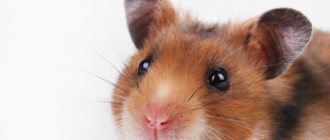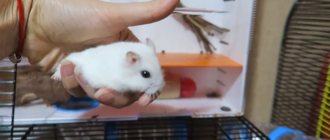Hamsters are quite popular pets, which seem to be completely unpretentious and do not require much of your time or careful care. In some ways this is true, hamsters do not require as much attention as, for example, dogs. But you need to take care of hamsters regularly and very carefully, monitoring what they eat and the conditions in which they live. Otherwise, you may encounter health problems with your pet. In this article we will talk about eye diseases of these animals. Why do hamsters have red eyes? Why do they turn sour or become bulging? How to recognize the first symptoms and how to treat the animal in order to destroy the source of the disease as quickly as possible.
Why does a hamster's eye not open or fester?
Almost always, eye problems in a pet are associated with disease and inflammation. They occur under improper conditions of detention, due to injuries, reduced immunity, etc. In rare cases, the animal’s eyes do not open due to an allergic reaction. This can be considered a relatively harmless reason, since it can be easily eliminated without causing harm to the pet’s health.
Allergic reaction
An allergy is an incorrect reaction of the body to substances that come into contact with cells of the immune system. Disruption of the latter is the cause of intolerance. The disease may be accompanied by redness of the skin, itching, nausea and vomiting, etc.
The pathology is more common in Djungarians, although it can occur in representatives of any breed.
If your hamster has a watery eye or swollen eyelids, you should suspect intolerance. In advanced cases, the animal independently damages the mucous membrane due to itching, which can lead to the development of conjunctivitis.
Unsanitary conditions
Unsanitary conditions pose a danger to your pet due to the high risk of infection. Against the backdrop of rare cleanings, active proliferation of microbes begins in the filler.
Regular cage cleaning will prevent the development of eye diseases in hamsters.
The delicate mucous membranes and immune system of the animal cease to cope with the excess of pathogens. As a result, owners are faced with problems such as red eyes in the pet, inflammation, purulent discharge, etc.
Veterinarians recommend cleaning 2-3 times a month so as not to cause stress in your pet and at the same time prevent infection.
Injuries and wounds
A hamster may accidentally injure itself. For example, getting out of a cage and falling or colliding with a sharp object. Animals often damage their mucous membranes due to litter or food particles.
If living together is not organized correctly or the level of stress is high, pets can fight and injure each other.
If the owner witnesses a fight between rodents, he needs to examine the pets and monitor their condition for several days. The wound may not become inflamed immediately. If there is even minor damage in the area of the visual organs, treatment should begin immediately, without waiting for symptoms to appear.
With a fresh wound, swelling and redness can be detected. The eye waters, hurts, and causes discomfort to the animal. An injured hamster hides and tries to spend more time in hiding. He moves little and sleeps more often. If left untreated, the damaged area may become infected. In this case, conjunctivitis develops.
Animals can injure their eyes in a fight.
Reduced immunity
The deterioration of the immune system in itself is not the reason why the eye may become watery or swollen. However, against this background, the development of other pathologies, including the organs of vision, is facilitated. Decreased immunity can be associated both with improper conditions of detention and with concomitant diseases. For example, lesions of the gastrointestinal tract. Even stress and bathing can trigger disruptions in the immune system.
Video “Caring for Hamsters”
How to properly care for hamsters so that they never get sick is described in the video below. Video taken from the Rostovlife City Portal channel.
Sorry, there are no surveys available at this time.
Was this article helpful?
Thank you for your opinion!
The article was useful. Please share the information with your friends.
Yes (100.00%)
No
X
Please write what is wrong and leave recommendations on the article
Cancel reply
Rate the benefit of the article: Rate the author ( 5 votes, average: 4.20 out of 5)
Discuss the article:
Injuries and inflammatory processes and their symptoms
In inflammatory processes associated with pathologies or injuries, the following symptoms occur:
- edema;
- inability to open eyes, squinting, trembling eyelids;
- liquid or purulent discharge, tearing;
- formation of a cone or barley;
- redness of the damaged area;
- hair loss on the eyelids and around the eyes.
The presence of these manifestations indicates infectious or age-related pathologies, and sometimes mechanical damage. In the latter case, infection with pathogens may occur later if the animal was not treated in time or the pet’s immune system is weakened.
When infected, the general condition further worsens. The pet refuses water and food, vomits, and digestion of food is disrupted.
Corneal damage
Damage to the cornea occurs more often in mobile, active animals. In most cases, the condition is associated with mechanical trauma.
Corneal damage often occurs due to mechanical trauma.
Shards, dust, sand, filler, etc. can get into your eyes. Sometimes the damage is caused by a scratch. In rare cases, the integrity of the cornea is compromised due to infectious pathologies, contact with chemicals and congenital pathologies.
If the pet's cornea is damaged, visual acuity decreases. The problematic eye is closed or squinted, the eyelids tremble. Sensitivity to irritants is increased: the pet hides in a bright room and suffers from severe lacrimation. The general well-being of the animal worsens. The mucous membranes turn red.
If damage to the cornea is associated with a foreign object, there is a chance that the latter will be removed without third-party intervention along with the discharge. Otherwise, you need to visit a veterinarian. After removing foreign bodies, the eyelids are washed with antibacterial agents and anti-inflammatory drugs are used.
Blepharitis
Blepharitis is an inflammatory process that primarily affects the eyelid rather than the eye. However, these are neighboring tissues, so as the disease develops, the organs of vision also suffer. Blepharitis develops due to many reasons. For example, due to bacterial infections, incorrect use of medications, inflammatory dermatological pathologies, gastrointestinal problems, etc.
Blepharitis is accompanied by purulent inflammation of the eyelids.
Blepharitis is characterized by changes in the color of the eyelids. They may darken, but more often they turn red due to inflammation. Sometimes the skin on them peels off. The animal suffers from itching. It scratches your eyes and can damage them. Another problem is weakening of local immunity and possible infection. Bumps often form on inflamed eyelids.
Blepharitis of the eye is usually treated with antibiotics. Additionally, it is important to maintain cleanliness in the cage and provide your pet with time. This will prevent the progression of the disease and infection of the tissues.
Abscess
Another name for an abscess is stye. This is not an independent disease, but a symptom. It can occur against the background of blepharitis, weakened immunity with concomitant infection, etc. When an abscess appears, the appearance of the eye changes, and a difference in size becomes visible due to the tumor. The temperature of neighboring tissues rises as a result of inflammation.
With an abscess, itching occurs, and sometimes mucous discharge appears. In rare cases, barley goes away on its own, but more often it requires veterinary intervention. Recovery occurs after the capsule is freed from pus.
Blunt trauma
A rodent can receive blunt trauma as a result of a fall. Sometimes an animal is accidentally crushed while walking. As a result, massive damage to all structures of the visual organs occurs. It is accompanied by severe hemorrhage. In case of injury, only 1 eye or both may be affected. A few hours after the injury occurs, the blood settles and the tissues turn red. The entry of blood particles into the vitreous body causes vision loss.
In case of injury, damage to one eye is typical.
If a blunt injury occurs, the animal should be taken to a veterinarian as quickly as possible. It is impossible to make a prognosis and cure your pet at home on your own. You can only provide first aid if you cannot visit the clinic in the near future. Apply a cool cloth soaked in saline solution to the damaged area and use antibacterial ointment. The latter prevents the cornea from drying out in case of severe swelling, if the animal cannot blink.
Conjunctivitis
Conjunctivitis is the most common eye disease found in hamsters. The pathology is characterized by bilateral inflammation, although this is an optional sign. The disease develops due to mechanical trauma, irritation from chemicals, infections, allergies, etc. The animal can become ill when in contact with household products, such as floor cleaning solution or hairspray. Filler, dust or sand can provoke inflammation. Poor quality litter injures mucous membranes.
With conjunctivitis, the animal's eyes begin to water.
Symptoms help indirectly determine the cause. In the initial stages, if the disease is caused by mechanical irritation or allergies, the discharge from the eyes will be clear. If there is an infection, the liquid becomes cloudy and later acquires a yellow or greenish tint. The animal can become infected with pathogens during the process if it is not given timely assistance.
Other symptoms include itching, pain, photophobia and watery eyes. The eyeball enlarges, the eyelids swell. To eliminate symptoms, anti-inflammatory and antibacterial agents are used.
Bacterial infections
Bacterial infection can be either an independent or concomitant disease. Most often, conjunctivitis develops as a result of the penetration of pathogens. An animal can become infected if it has a weakened immune system, is injured, has a damaged cornea, etc.
Bacteria multiply quickly, especially if the damage is deep. Without help, pathogens increasingly penetrate tissues. Subsequently, the bacteria, along with the bloodstream, are spread to all organs and systems, which can lead to the death of the animal. In case of deep infection, it is necessary to resort to surgical intervention, including removal of the eye, in order to save the hamster’s life.
Bacterial and viral diseases of the hamster
Hamsters are very susceptible to diseases caused by pathogenic microorganisms, viruses, and bacteria. Infection is possible by contact, aerogenous, nutritional means, or by eating low-quality feed. Some diseases of bacterial etiology can be transmitted to hamsters from humans and other pets.
Colibacillosis
The infection is caused by Escherichia coli, which parasitizes the gastrointestinal tract of animals. This disease of dzhungarik is also known as “wet tail”, as the sore is manifested by severe diarrhea.
Other symptoms of colibacillosis include:
- decreased, lack of appetite;
- weight loss;
- restless behavior;
- depression, lethargy, apathy;
- drowsiness;
- the presence of wet fur near the anus.
Hamster stool with diarrhea has a watery consistency. The hamster constantly curls up into a ball, hides in secluded places in the cage, and looks untidy.
The disease is characterized by an aggressive course and spreads very quickly, therefore, when keeping several animals together in a cage, you must immediately move the sick pet to another home. The disease can be cured only in the early stages of development.
Diplococcosis
An infection of the respiratory tract caused by round microscopic bacteria called diplococci. The main symptoms are lethargy, apathy, decreased activity, discharge from the nose and eyes. If the infection is severe, the dzhungarik refuses food and treats.
The disease requires immediate treatment using special serums. If therapy is not started, the pet’s death occurs on the second or third day.
Salmonellosis
The disease is caused by pathogenic rod-shaped microorganisms - salmonella. With this infection, hamsters experience foamy diarrhea, weakness, apathy, and pale mucous membranes.
A sick hamster refuses food, hides in a dark corner, sits motionless, showing no interest in the world around it. The rodent's tummy is enlarged.
In the stool you may notice bloody clots, threads, particles of undigested food, and mucus.
Viral pneumonia
The disease develops against the background of weakened resistance and weakened immune potential. Prolonged hypothermia, chronic otitis, hypo-, avitaminosis can also cause the development of viral pneumonia in animals.
The disease is manifested by abundant mucous, mucopurulent discharge from the eyes, nose, refusal to feed, coughing attacks, and shortness of breath. The hamster has a wet muzzle, hoarse, rapid breathing, and pale mucous membranes. If he shakes his head, his ear, wax has accumulated in the ears, there are crusts and an unpleasant odor emanates, most likely the animal is sick with otitis media, the cause of which is a respiratory illness.
Pneumonia develops against the background of ophthalmological diseases or can provoke eye and ear diseases. With timely treatment, the hamster recovers completely within a week.
Aujeszky's disease
Pseudorabies is a deadly viral disease. The disease manifests itself as severe nervous disorders. The hamster becomes restless and may show aggression. Attacks of excitement are replaced by complete apathy. A sick pet has poor coordination of movements. Muscle spasms and cramps are noted. Death occurs due to paralysis and severe exhaustion. Treatment is carried out with special serums.
Lymphocytic choriomeningitis
One of the viral infections that poses a danger to humans. May be latent (asymptomatic). The main signs are sudden weight loss, decreased activity, refusal to feed, frequent bowel movements, and urination. Most often, the virus is transmitted from a hamster to newborn hamsters. In pregnant females, the disease provokes spontaneous miscarriages.
The infection is incurable, so if your pet is infected, it will unfortunately have to be euthanized.
How to treat inflammatory eye diseases
In case of inflammatory diseases, they try to provide rest to the animal. Rinsing is carried out to prevent eyelid sticking, infection and increased discomfort. If the eye is already infected with pathogens, the procedure prevents bacteria from further penetrating into the deeper tissues.
The filler must be removed from the cage. It is replaced with paper towels. All accessories are disinfected with hot water and soap. The cage is placed in a dark place.
Choice of medications
The choice of medications depends on the nature of the pathology. Anti-inflammatory drugs are most often used. The most neutral drug is saline solution. It is used to wash and moisturize the eyes. It does not cause tissue drying, and therefore does not contribute to further infection.
In most cases, antibiotics are included in the treatment regimen, even if there are no signs of bacterial infection. This prevents infection due to weakened immunity.
Preference is given to local drugs, since generic ones are ineffective.
If necessary, the discharge is removed with a soft sterile swab soaked in saline solution. For infection, use Furacilin. If there is no improvement within 2-3 days, use Tobrex or Floxal drops. If necessary, take a long break between washes and add ointment.
Drops for the treatment of inflammatory eye diseases in hamsters.
Cleaning your eyes at home
The eyes are washed with saline solution, weak tea leaves, chamomile infusion or Furacilin. To do this, take a soft swab or cotton swab, moisten it in the product and carefully move it from the corner of the eye towards the outside. You can't go against the grain when eliminating discharge. This will cause dirt to get into deep tissues. Do not press on the skin. This traumatizes the pet. A separate swab is used for each eye.
Diet restrictions
The menu during illness is strictly limited. The pet is fed mainly grain crops, and animal proteins are given in small portions. Diet diversity is avoided due to weakened immunity and the need to reduce the load on the gastrointestinal tract.
Redness
If the hamster has one eye closed, but has not festered, but only turned red, at first you can help him on your own. At home, you can make a weak saline solution from boiled water and wash the inflamed organ with it several times a day.
Salt as an antiseptic eliminates any pathogenic microflora formed on the mucous membrane. You can also use chamomile infusion or black tea brew as an antiseptic.
You need to wash your hamster's inflamed organs of vision at least three times a day.
If such preventive treatment is useless and you have not opened your pet's eyes, you need to take your pet and show it to a veterinarian.
Conjunctivitis
This disease affects not only people, but also animals - the hamster is no exception. Moreover, the treatment of such a disease is quite difficult for domestic hamsters. In some cases, if timely measures are not taken, the animal may simply die.
Conjunctivitis is the initial stage of one of the most serious pathologies in an animal. If a hamster's eye festers and does not open, perhaps some kind of infection or virus has settled inside its body. At an advanced stage, conjunctivitis can cause the development of keratitis, and then it is not far from such a pathology as protrusion of the cornea. What to do in such a situation so as not to trigger the disease?
Therefore, if a hamster’s eye is swollen, very swollen, and its owner does not pay attention to his pet, first the rodent may go blind, then die completely.
The same outcome awaits those pet rodent lovers who do not approach the treatment of their animals competently. Remember that any treatment prescribed independently can result in disastrous consequences for your own household.
Treatment for droopy eyes
If an animal's eyes are stuck together, you should not try to forcefully separate the eyelids - this will lead to injury. In this case, rinsing is carried out, but the crusts are generously moistened with a medicinal agent. After this, they soften and become easier to remove.
To eliminate eye stickiness, you should clean your eyelids with saline solution.
Conjunctivitis
Both of these diseases are extremely dangerous and require timely treatment. Of course, you should contact a clinic to make a diagnosis and prescribe therapy. However, if this is not possible, then you can recognize diseases and cope with them yourself.
The main signs of developing conjunctivitis are:
- yellow or green pus with a specific odor that accumulates in the corners of the eyes and causes them to stick;
- inflamed eyelids, noticeable swelling or swelling;
- hair loss around the organs of vision;
- temperature, general weakness, apathy and lack of appetite.
The hamster constantly keeps his eyes slightly squinted or does not open them at all. The animal is so apathetic that it can simply lie there, not reacting to light, braking, or tasty food.
For treatment you need to use Albucid eye drops. The medicine needs to be instilled three times a day. Recovery takes from three days to a couple of weeks. The timing depends on how advanced the disease is, the general state of health, and the age of the hamster.
Non-inflammatory diseases
Non-inflammatory diseases include cataracts, cataracts, glaucoma and oncological pathologies. Some of them are related to genetics or age-related changes. In general, such pathologies progress more slowly, making it more difficult for owners to notice the symptoms.
Belmo
A cataract is characterized by the appearance of a white spot on the surface of the eye. The cause of the disease is trauma, and less commonly, cataracts. With massive damage, the stain can cover the entire surface. If some of the mucous membranes turn white, you need to contact a veterinarian. This will help distinguish the eyesore from other pathologies. The disease has no cure, but does not threaten the life of the hamster. The animal's vision may deteriorate.
An eyesore is caused by injury or cataracts.
Cataract
Cataracts in a hamster develop due to a metabolic failure in the lens. If the disease progresses, it leads to blindness. It is assumed that the pathology develops due to injuries, old age, frequent stress, etc.
Cataracts in rodents cannot be treated. Surgical intervention is not used for pathology, and eye drops are ineffective. The disease is easier to prevent than to cure. To do this, the pet is fed plant foods rich in retinol, is not given sweets, vision pathologies are promptly eliminated, and the cage is not placed in the sun.
Glaucoma
Glaucoma is characterized by increased eye pressure. Because of it, the tissues increase in size and begin to bulge. The pet is in pain. Without help, the eyes fall out or leak. The only thing a veterinarian can do in this case is to perform enucleation. The animal will lose vision, but the procedure will prevent infection and relieve pain.
Glaucoma causes increased intraocular pressure and is accompanied by bulging of the eyeballs.
Oncological diseases
A lump in the eye area may not be blepharitis, but a malignant tumor. There is no generally accepted effective treatment in this case, but you can try to save your pet. To do this, they turn to a ratologist to remove the tumor, after the operation they use antibiotics, drugs to strengthen the immune system and vitamins. Even if the treatment does not save the animal, it will improve its condition.
Eye diseases associated with aging changes in the body
Very often, with age, hamsters develop such an unpleasant disease as cataracts. It manifests itself as white spots, clouding of the lens, and blurred vision. The animal gets really stressed because it begins to see poorly. Unfortunately, this disease can rarely be cured; all that remains is to make the animal’s life as easy as possible by following certain tips:
- Do not place the hamster's cage in direct sunlight, this will further irritate the eyes and worsen the situation;
- Don't give your animal a lot of sweets. In return, give a lot of carrots and zucchini.
- Do not place many objects in the cage, because due to poor eyesight the animal may hit them and injure itself.
This is all you can do for your pet to somehow make his life easier.
Blepharitis
This disease may be a consequence of advanced conjunctivitis. In this case, the inflamed eyelid sticks together, and the inflammatory process spreads deeper and deeper inside. At an advanced stage, both organs of vision may be closed. This disease is accompanied by redness and swelling of the eyelids.
What to do in this case? This disease can be treated if you consult a veterinarian in time. Often the treatment regimen is identical to the treatment regimen for conjunctivitis. Often, special eye drops are used in the treatment of this disease, for example Tsiprovet or Floxal, as well as additionally tetracycline ointment.
With this disease, the hamster should be put on a diet and the cage should be disinfected.










